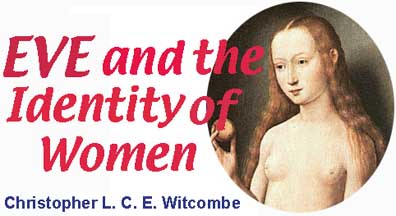|
||||
|---|---|---|---|---|

Eve
|
2. Eve in Genesis
Genesis has been subjected to any number of interpretations, none of them satisfactory to the modern mind. Though the intent of the story is clear, as a narrative it lacks sense. Even the literalists who want to read it as straight fact find themselves following pretzel-like paths of explanation.
Apart from such knotty and awkward questions as from whence came evil in a new world God proclaimed as "good," and the incestuous situation which must have prevailed for the human race to continue (by whom did Cain father children?), a fundamental problem is the fact that the story has two different accounts of the creation of man.
The first is told briefly in Genesis 1:27: God "created man in his own image, in the image of God he created him; male and female he created them."
The term "man" in this instance is to be understood in the collective sense as meaning mankind. This plural or inclusive use of the word "man" is made clear in Genesis 5:2 where it is again stated that "Male and female he created them and blessed them and called their name man on the day of their creation." The passage therefore may be interpreted to mean that men and women were created in one act, both sexes together, equally and at the same time.
The second, much lengthier account is given in Genesis 2 and 3. Instead of simultaneous creation, the story tells first of God forming man out of the dust, breathing life into his nostrils, and setting him down in the garden of Eden.
Only after the first act of creation does the story go on to recount the making of a woman from the man's rib, the story of the serpent's temptation of the woman, and the subsequent expulsion of the man and the woman from the garden into our world.
Biblical scholars currently believe that the first account given in Genesis 1:27 was written much later than the second story, having been composed according to the "P" source or "Priestly Code" (so called because of its cultic interests and regulations for priests) probably by Jewish theologians around 500-400 BCE.
The longer second story, related more in the language of folklore, is derived from the "J" or "Yahwist" source (so called because it used the name Yahweh [Jehovah] for God) and was probably written down by members of Hebrew tribes around 1000-900 BCE during the time of King Solomon.
An earlier version of this essay appeared originally in Images of Women in Ancient Art
Copyright © (text only) 2000. Christopher L.C.E. Witcombe
|
|||


